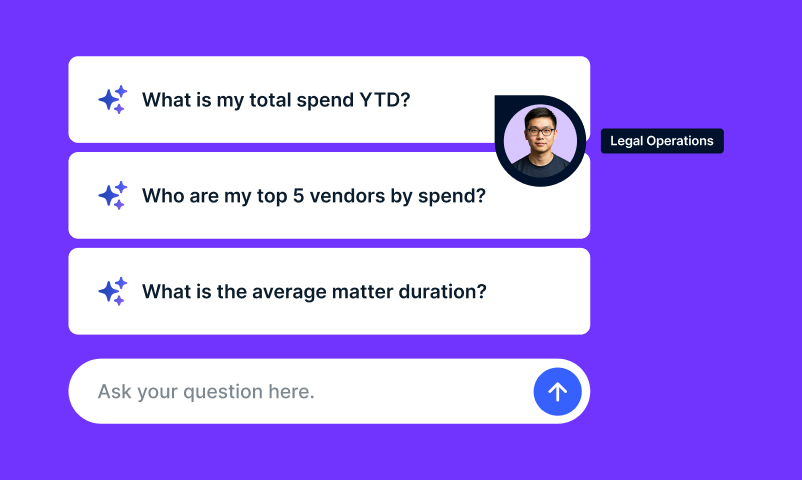
Let’s be honest: if you’re not measuring your legal department KPIs, you’re flying blind. The modern legal team is expected to prove their value, support the business’s strategy, and ruthlessly optimize legal spend management. If you aren’t there yet, you’re overdue for a change.
Stuck in spreadsheet hell? You’re not alone, but you’re also not going to win the future that way. Legal reporting best practices and technology can take you from manual chaos to automated clarity. The best part? You don’t need a massive analytics platform to crush your KPIs. Start with structure, consistency, and the four hacks below to unlock performance data that actually matters.
1. Legal department KPIs are your leverage
Legal department KPIs aren’t just pretty numbers for a slide deck. They’re your narrative. They tell leadership exactly how your team impacts the bottom line and why you should have a seat at the decision-making table. This aligns with broader business guidance on performance measurement, like Harvard Business School Online’s breakdown of how effective KPI structures drive organizational decision-making. Quantified, strategic, and focused: that’s how forward-thinking legal leaders play the game.
Even if you’re building from scratch, laser in on high-impact metrics: efficiency, risk reduction, alignment with business goals. This isn’t an optional exercise. It’s your ticket to credibility.
Still tracking data privacy costs manually and watching them climb? There’s your smoking gun. Use those insights to push for process changes, justify training, or argue for in-house moves that slash outside counsel spend. Strong legal department KPIs tell a story the C-suite can’t ignore.

2. Cut the fluff: Choose legal department KPIs that actually matter
Let’s talk results. Your legal KPIs must expose the link between legal effort and business value. Ditch vanity metrics and focus on what drives decisions.
Start with these proven performers for both legal spend management and operational rigor:
- Actual spend by month: Own your budget, find burn points, and spotlight cost control.
- Total hours billed: Reveal capacity constraints and dependency on outside counsel.
- Discounts, adjustments, alternative fee arrangements: Show you don’t just spend. You negotiate and save.
- Number of contracts executed: Measure how legal accelerates (or blocks) deals.
- Matters resolved and time per matter: Find choke points, boost efficiency, and rebalance workloads.
If you’ve got access to AI-native analytics or enterprise legal management tools, level up:
- Top matters by attorney hours and rate: Pinpoint where you’re leaking money or over-allocating talent.
- In-house vs. outside counsel workload: Stop outsourcing what you should be running internally and vice versa.
- Line-item spend breakdowns: Kill off travel drains, admin bloat, and research inefficiencies.
Reporting on these KPIs isn’t about making leadership happy. It’s about controlling your narrative, driving legal reporting best practices, and putting yourself in the driver’s seat for strategic initiatives.
Pro tip: Modern legal ops solutions automate dashboards and reporting, letting you focus on strategy instead of spreadsheet migraines.

Quantitative KPIs: Don’t guess, prove it
Dig deep into your data. Your in-house timesheets and coded invoices hold gold if you know how to mine it. Build your legal spend management story from the numbers, not just gut feelings.
Track reductions and overruns by line item. Follow the money. Compare workloads and costs across practice areas over time. Trends don’t lie, so use them to predict, pivot, and persuade.
Qualitative KPIs: Influence beyond the numbers
Some of your impact is beyond the spreadsheet. Smart legal reporting best practices mean capturing qualitative wins too. Did negotiating a high-stakes deal save the company millions? Shout it out.
Ask your business partners for honest feedback. Are they waiting too long for support? Do they feel legal is a strategic enabler or a stubborn bottleneck? Build internal surveys and measure what matters, not just what’s easy to count.
3. Ditch the data dumpster: Build smart records around legal department KPIs
Your KPIs are only as good as your data hygiene. Step up your legal reporting best practices:
- Tag invoices precisely. If it doesn’t drive a KPI, why track it?
- Train your squad on the critical fields. Everyone must play by the same data rules.
- Standardize formats for ease, speed, and auditability.
- Stay compliant. The regulators will thank you, plus you’ll sleep better at night.
If the company demands ruthless efficiency, your systems and reporting must make cost savings unmistakably clear. Legal department KPIs are your ammunition. Organize them, defend them, and use them to drive real change.
4. Track legal department KPIs the modern way, or get left behind
Let’s face it. Spreadsheets are a stopgap, not a solution. They’re better than nothing, but if you want to bring the heat, automation and real-time dashboards are your best friends.
Pull all your legal department KPIs, legal spend management data, and performance metrics into one simple view for leadership. No more scrambling before the next quarterly report. Let cloud tools and visualization software do the grunt work so you can focus on results.
When you’re ready to stop living in the stone age, migrate to an AI-native solution. Let automation run the numbers, surface trends instantly, and produce dashboards executives actually want to read. The future of legal reporting best practices is real-time, interactive, and smart.

With the right tech, your team can:
- Build automated dashboards that make spend, matter cycles, and vendor performance instantly visible.
- Slice KPI reports by team, region, or matter type with ease.
- Share insights in seconds, not days or weeks.
Time to upgrade or be outpaced
A basic spreadsheet works until it doesn’t, then you need a legal ops platform that automates data management and reporting. Modern legal analytics tools are purpose-built for legal department KPIs. Get dashboards you can trust, share insights on autopilot, and keep leadership looped in with zero manual hassle.
Ready to wield real influence? Sharpen your KPIs and build a truly data confident legal department by checking out our guide, Math of Legal Ops: Numbers, Process, and People Driving the Bottom Line.
It breaks down the real mechanics behind legal performance, spend control, and operational impact, and shows why manual math has no place in modern legal ops.
Click here to download the guide.














